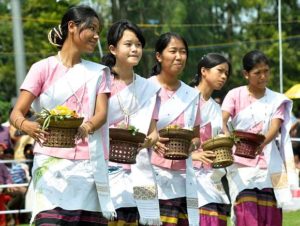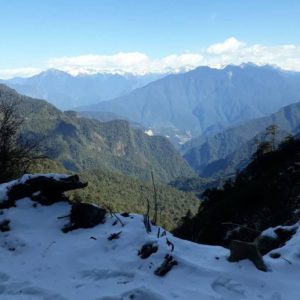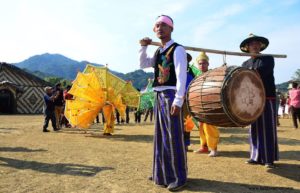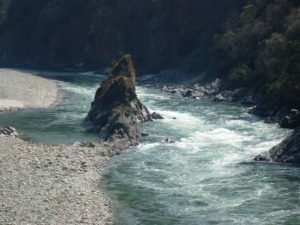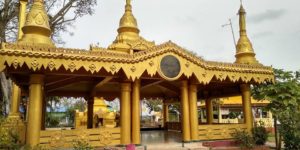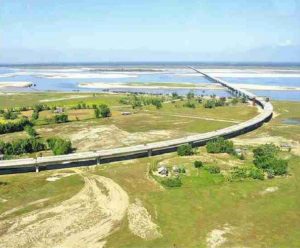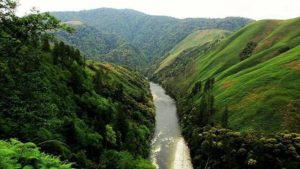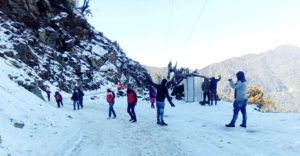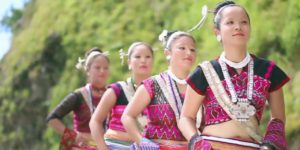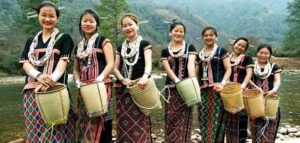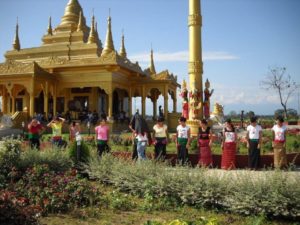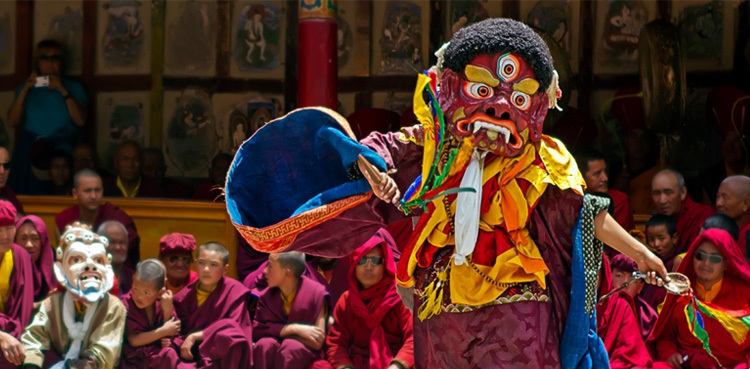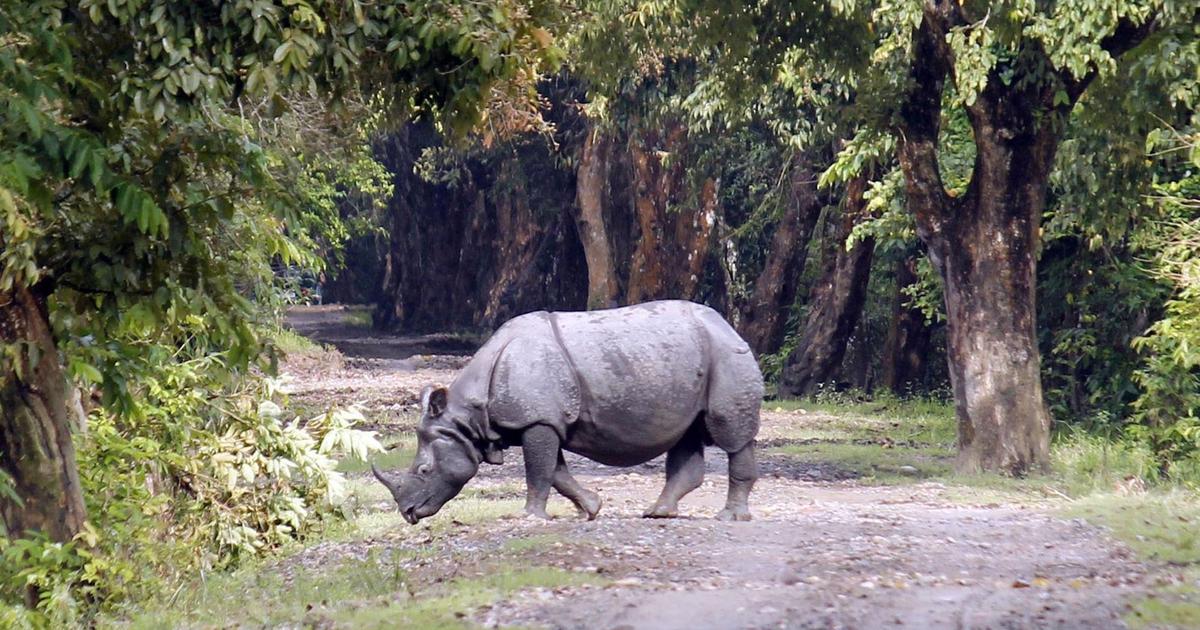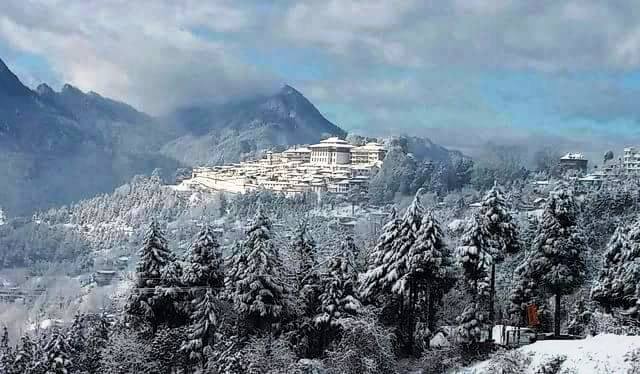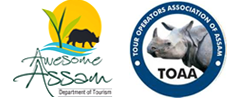Tour Highlight
- Tai Phake Women
Experience the unique cultures and traditions of the Tai Phakes and Sonowal Kacharis, few of Assam’s aboriginal communities.
- At Mayodia Pass
Feast Your Eyes On The Panoramic View Of Verdant Valleys, Gushing Rivers and Snow-Clad Mountains of Eastern Himalaya as you embark upon to Mayodia.
- Khampti tribesmen
Explore the villages of the Idu Mishmi and Khampti tribes and get a glimpse of the lives and colours of these lesser known communities of Arunachal Pradesh
- Parshuram Kund
A visit to Parshuram Kund will give you the chance to get indulge in meditation and introspection amid its pristine surroundings and get home an everlasting experience of savouring heavenly nature.
Itineraries
Day 01: Arrive Dibrugarh
Meeting upon arrival and transfer to hotel.
Evening free at leisure.
Overnight at hotel.
Day 02: Dibrugarh / Tai Phakial / Dibrugarh (85 kms one way, 2 hrs drive)
Morning after breakfast drive to Tai Phakial Village.
- Namphake Buddhist Monastery
Thai Phakial – (The Tai words ‘Pha’ meaning wall and ‘Ke’ meaning ancient or old.) The Phake is also known as the Phakial, they had migrated from Thailand to Assam in 18th centuary, they speak Thai language. Even during the modern time they still follow their traditional culture. The have a fine tradition to keep their family record, the name of the record is Ho Likboi, generally the elder of the family known as the Pathek is well versed prepare the record. They practice Buddhism, there is a Buddhist monetary in Namphake village established in 1850 the monks in the monasteries is known as CHOW MOUN . They also have the sound knowledge in Pali language. The residence claim to be 100% literate. One interesting fact is that the villager claims the police had never entered the premises as because the Monks settled the disputes among the villagers, they also rely on Herbal cure. They marry within there community only but there is no restriction if someone wants to marry from outside. They are basically patriarchal society the son inherits the fathers property. Though few in number and in spite of an identity crisis, the Tai Phakes have been able to maintain their glorious legacy.
Later visit a Sonowal Kachari Village.
The Sonowal Kacharies: Even before the advent of the British in Assam, the Sonowal Kacharies had been living at Haldibari of upper Majuli. They are known to be the Tibetan-Burmese branch of the Mongoloids of the Bodo origin. When the Ahom invaded Assam, the Kacharies put up a brave fight against them. Due to continue battles, some of them were force to leave their original place living and settled in a scattered way here and there. Thus the Bodo, the Mess, the Hajong, the Rabha, the Dimasha, the Lulong, the Thalang and Sonowal etd. came into existence of the Kacharies. The term Kachari is very difficult to trace. It is assumed that during the reign of Ahom King some of the Kacharis were engaged in washing gold particles from the sands of river and therefore the prefix Sonowal” was added to signify them. According to an anecdote the kacharis of upper assam who became the disciple of Gossain named Kachaideo were considered to have super natural powers of offering a certain quantity of gold in a bamboo tube while the Ahom king Gadadhar singa was on the throne. and these people came to be known as Sonowal Kacharis. The sonowals were offered non tribal titles like Hazarika, saikia , Bora in their process of assimilation with the non tribal people, specially during Ahom Rule.
Later return to hote in Dibrugarh.
Overnight at hotel.
Day 03: Dibrugarh / Roing (195 kms, 5 hrs drive)
Morning after breakfast drive to Roing.
- The Bhupen Hazarika Setu
En route cross the Brahmaputra river by the Dr. Bhupen Hazarika Setu (Dhola – Sadiya Bridge) which is the longest bridge in India (9.15 Kms)
Roing: Roing is a census town in Lower Dibang Valley district in the Indian state of Arunachal Pradesh.The only town under Idu Mishmi dominated areas, has Mehao wild life sanctuary, Sally lake, Mehao lake and Mayudia mountain pass that remains covered with snow during peak winter. The town, located at the foothill of the Mishmi Hill is lively with friendly people.
- View of Roing
Arrive and check in at the traditional guest house.
Overnight at guest house.
Day 04: Roing / Mayodia / Roing (57 kms, 2 hrs drive)
Morning after breakfast visit Mayodia
- Mayodia
Mayodia, a unique hill resot situated at an altitude of 7000feet. It is named after Maya, a Nepali girl who missing in the snow and could not be traced out. It is an ideal trekking destination and paradise for bird watcher as many endangered specis are recorded including Trogopan. The scenic beauty of the snow clapped Miodia during winter is eye-catching. Miodia is 56 kms from Roing, the district head quarter of Lower Dibang Valley
Later return to Roing.
Afternoon visit a Idu Mishmi village
The Idu Mishmi is a major sub-tribe of Mishmi group. Their brethren tribes are namely the DIGARU-MISHMI (TARAONS) and the MIJU-MISHMI (KAMANS).
The Idu Mishmi is one of the two major tribes of the area. The Idu Mishmis can be distinctively identified among other tribal groups of Arunachal Pradesh by their typical hairstyle, distinctive costumes and artistic patterns embedded on their clothes.
People of sober nature still maintain deep-rooted aesthetic values in their day-to-day life with great pride and honour.
- Idu Mishmi tribal women
The Idus have their distinct dialect, which falls under the Tibeto-Burman group of languages. Traditionally, Idus believe in animism. They worship several benevolent and malevolent spirits. Nani-Intaya and Masello Zino are worshipped as creators of mankind and universe as a whole.
Mythological characters like SINE-RU a first IGU (Idu Priest) still holds high place and reverence in the minds of the people. The prints of his palm on the huge rocks at Athu Popu near Keyala Pass in Dibang Valley district on China border, is supreme and holy shrine.
The Idus are expert craftsman. The Idu women, in particular, are very good weavers. Their great aesthetic sense is well reflected in the exquisite designs created on the clothes produced on handlooms. The Idu men are well apt in making beautiful basketry items of bamboo and cane.
Overnight at guest house.
Day 05: Roing / Tezu (110 kms, 4 hrs drive)
Morning after breakfast depart for Tezu.
Tezu: Tezu is a small town and the headquarters of Lohit district of Arunachal Pradesh.
The ancient inhabitant of this beautiful land of valley and rivers are the Mishmi tribes. This tribe still has a King and Queens residing in the district headquarters of Tezu. The Mishmi tribes have a rich tradition and customs dating back to the times of Mahabharata. It is said that Rukmini of Mahabharata was a Mishmi Damsel.
Arrive and check in at the tourist lodge (Basic accommodation)
Afternoon visit a Mishmi tribal village
- Mishmi Tribal Women
The Mishmi an ethnic tribe comprising of mainly three tribes: Idu Mishmi; Digaru (Taraon) Mishmi, and Miju(Kaman) Mishmi. The Mishmis occupy the north-eastern tip of the central Arunachal Pradesh in Upper and Lower Dibang Valley, Lohit and Anjaw Districts. The three sub-divisions of the tribe emerged due to the geographical distribution, racially all theses three sub tribes are of same origin but there are unnoticeable difference among theses sub-tribes, i.e. of ORIGIN and DIALECT.
Overnight at tourist lodge.
Day 06: Tezu / Chongkham/ Dibrugarh (270 kms, 6 hrs drive)
Morning after breakfast depart for Dibrugarh.
En route visit
- Parshuram Kund
Parasuram Kund: Parasuram Kunda, a place of pilgrimage is situated in the bank of the river Lohit at about 24 Kms from Tezu. It is also known as ‘Prabhu Kuthar’, the origin of the ‘Kunda’ viz. Parasuram Kunda is associated with Parasuram’s matricide. The history goes in brief that one day Renuka, mother of Parasuram went to Ganga for having bath and bringing water. But delay in bringing water made the Rishi Jamadagni, the husband of Renuka very angry as it was already getting late for the mid day worship. He asked the sons to kill her. None of his six sons except Parasuram could oblige. Parasuram chopped off the head of his mother indeference to the wishes of his father, but as a result of crime handle with his axe got struck to his hand. Jamadagni was very pleased with him for carrying out his order and asked Parasuram to have for boon.
Parasuram pray for bringing his mother back to life, then enquired as to how to get rid of the crime of matricide. Jamadagni granted it and his mother got her life back and told Parasuram to visit ” Brahma Kund” to wash off the sin. Parasuram came to the Brahma Kund, in Lohit District of Arunachal Pradesh for holy dip in the kunda. Religious people, saints come to this kund on Makarsakranti which falls on the 14th January every year. The Govt. of Arunachal Pradesh extend all possible arrangement/help to those pilgrimage.
Chongkham: There are several Buddha-Vihar locally called CHONG in the Khamtis area. The world Peace Pagoda located in a river island at Chongkham is ideal for meditation in front of Buddha statues that surrounds in inner core of the vihar.
- Khampti Women
The Khamti Raja’s Chong at Guna Nagar at Chongkham is famouse for relics of Gautama Buddha. All the CHONGs and statues of Lord Buddha are made in the Thai-architectural style. There is no ban to visit these CHONGs.
On the way you can visit another Khampti village. The Khamptis are traditionally owners of elephants, with which they work in the forests. They cut trees and the elephants pull them out of the forest.
Arrive Dibrugarh and check in at hotel.
Overnight at hotel
Day 07: Dibrugarh Depart
Morning after breakfast in time transfer to airport for the onward destination.
Tour ends.
Extension to Digboi and Jairampur
Day 01: Dibrugarh / Jairampur (180 Kms, 4 hrs drive)
Morning after breakfast depart by car for Jairampur.
Jairampur: It is the headquarter of Jairampur sub-division. The famous and historic ‘Stilwell Road’ passing through this small town from Ledo, Assam, India to Kunming, Yunnan Province, China via Burma. The World War II cemetery of about 1,000 graves of Allied Soldiers is located 6 Km away from Jairampur at the Nampong road.
Afternoon visit:
World War II Cemetery: The recently unearthed large Burial-ground with about 1,000 graves of allied soldiers believed to be mostly of Chinese, Kachins, Indian, British and Americans soldiers who died in Second World War is located at Stilwell Road (Ledo Road) in the Jairampur-Nampong road, 6 km from Jairampur town, 39 km from Ledo and 24 Km before reaching Pangsau Pass ( Hell Pass ), India – Burma (Myanmar) border. The hidden cemetery covered with thick jungles midst of the bank of Namchik River. The Army has cleared the area and found about 1,000 graves within an area of about three acre. The boundary was enclosed by concrete posts with entrance on three sides. The graves are arranged in five Lines and several rows with a large grave, possibly a mass burial in the centre. The bricks were from Ledo AR&T Co’s brick fields, and others marked as B&C-119 and IR.N!C9 were being used.
Overnight at guest house.
Day 02: Jairampur / Digboi (130 Kms, 3 hrs drive)
Morning after breakfast depart for Digboi.
Digboi: Digboi is the cradle the two modern wonders of the world– a hundred year old oil-field still producing and the world’s oldest operating oil refinery. Digboi is situated in Tinsukia District, at a distance of about 30 kms from Tinsukia town and about 522 kms from Guwahati. Digboi is the first Asian place where oil was found in 1889 and oil has been commercially produced since 1901.
Arrive and check in at the Refinery Guest House
Afternoon visit:
Digboi Centenary Museum: The Digboi Centenary Museum is a life gesture of the centenary celebration of Digboi Refinery which showcases the history of oil exploration in Asia. The museum offers a rich collection of machines, visuals, scale-models and photographs. The museum was inaugurated on 4th January, 2002. The IOC (Indian Oil Corporation) authorities have taken much pain to put the entire place in order, just beside the historic Discovery Well No. 1, unbelievably, crude oil continues to stream out naturally within a corner of the museum complex.
Digboi Centenary Environment Park: Another beautiful place of the town is The Digboi Centenary Environment Park, which is near the main entrance to the refinery. This park is a combination of nature’s beauty and Mans’ God’s gifted brain skill. This Park covers an area of 40,000 sq mtrs, this area also covers mesmerizing natural ponds and waterfall. There are the honeymoon bridges from where one would never want to leave. The hanging bridge above the huge pond with the elegant site of a dozen ducks swimming in there make the park more than attractive for young people. The green grass and the blessed flowers in the park rejuvenate life to the elders too. Other attractions of the park are the four fiber glass boats, where visitors can avail of the facility to fulfill its desires for a carefree life.
Margherita: 14 kms east of Digboi, this is the centre of Tea Gardens, Plywood factories and coal mines. There are a number of coal mines and locomotive railway engines aging about 100 years.
Rest of the time free at leisure.
Overnight at Guest House.
Day 03: Digboi / Dibrugarh Depart (75 Kms, 1 ½ hrs drive)
Morning after breakfast in time transfer to airport / railway station for the onward destination.
Tour ends.
Inclusion and Exclusion
THE PACKAGE COST INCLUDES:
- All transport by a dedicated vehicle
- Accommodation as per the itinerary.
- Daily breakfast at hotel.
- Permits required for entering into Arunachal Pradesh (Indian & Foreign Nationals)
- All parking, toll charges, driver’s allowances etc.
- 5 % GST as applicable
THE PACKAGE COST DOES NOT INCLUDE:
- Any meals other than mentioned above.
- Entrances to the monuments, parks other than mentioned above.
- Charges of the accompanying guide or local guide (if required)
- Any expenses occur due to natural calamities or which are not mentioned in the cost inclusions
- Any other expenses of personal nature i.e camera, laundry, telephone, any type of insurances, tips, portages etc.




